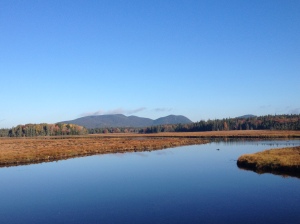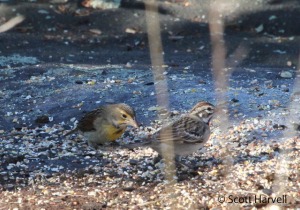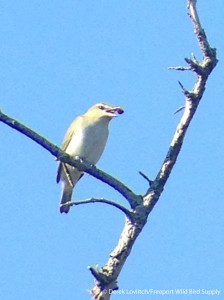A lot of people have been asking me about my opinion on Question 1 on the November ballot: “Do you want to ban the use of bait, dogs or traps in bear hunting except to protect property, public safety, or for research?” It’s complicated, so this is not going to be short. My opinion certainly doesn’t fit neatly into a yard sign or 30-second TV spot.
Not surprisingly, Question 1 has generated quite a bit of heated, passionate, and sometimes woefully misinformed debate. A recent bout of misleading television ads from both sides is not helping people make an educated decision – but more about TV later.
I majored in Environmental Policy at Rutgers University in New Jersey, with a minor in Wildlife Management. In one of my classes for my minor, I attended a public hearing for discussion on whether or not to institute a bear hunt in NJ. Needless to say, few facts were heard from either side of the debate. There was a lot of passion from both sides, but little in the way of actual information.
There are a lot of bears in NJ. In fact, it has the highest density of Black Bears per square mile than any other state. I’ve seen more bears in a single day during the World Series of Birding in NJ than I have seen in 13 years of living in Maine. We can discuss “cultural carrying capacity” (how big of a population we humans are willing to tolerate) versus “biological carrying capacity” (how big of a population the ecosystem can sustain), but it was safe to say that something was going to be done about the large population of bears in NJ, and a bear hunt was instituted in 2003. After 2005, it took another 5 years – and lots of court challenges – to resume the hunt.
A few years after graduating, I moved to Michigan. Working in the Upper Peninsula, especially for a summer of breeding bird atlasing, I encountered a lot of Black Bears. One thing immediately struck me as different from most of my bear encounters in NJ – Michigan bears ran away from you! They feared humans. And for a Black Bear, this is a very good thing. Bears that lose their fear of humans associate humans with food – bird feeders, dog bowls, beehives, and especially garbage, and an association with humans rarely ends well for a bear.
Therefore, even though I do not hunt anything, I fully support the wildlife management practice of hunting Black Bears. What I don’t fully support are some of the techniques used to hunt this intelligent and magnificent creature.
Looking again at Question 1, we see two methods that I, and a lot of people, am wholeheartedly opposed to: dogs and snares. Snares are archaic, cruel, and sometimes catch more than their intended quarry, including Endangered Species such as Canada Lynx. I hate snares, and I have zero respect for their use and those that use them. I want them banned.
In Michigan, and again in Maine, I saw bear dogs treated poorly. Crammed into tight containers and often brutalized, these are not usually the loyal family pets that accompany your average upland game or waterfowl hunter. Once again, it’s archaic, and for me, crosses the line of cruelty – in this case to both the dogs and the bear. I think it’s time for hunting bears with dogs to go.
And that brings us to baiting. And as you may have noticed, that’s where the discourse starts getting ugly. And my goodness, is there a lot of misinformation out there.
I am not as inherently opposed to baiting as I am to the other two tactics. In fact, I recognize the very real fact that a bear sitting still at a bait pile is a lot easier to kill quickly with a clean shot than a bear that is being tracked through the woods, or happens to mosey by a deer stand. Despite what supporters of Question 1 have claimed, it is simply impossible to compare the forests of Maine to the open forests of the west. Our forests are thicker, darker, and bears don’t concentrate as readily in open patches of food. Bears are harder to find in Maine, and harder to see. I ask you, how many bears have YOU ever seen in Maine?
Forget “fair chase.” As long as only one side has a gun, it ain’t “fair.” Therefore, I want a hunter to have the best chance at killing the bear as quickly and efficiently as possible, and in Maine that usually means over a bait pile. I do have concerns about the volume and the quality of human food that is being dumped in our woods, and I have a concern about fostering the association between humans and food. But I find it hard to believe that the amount of bait being dumped in the woods is large enough to make a significant difference to the population of bears as a whole. And yes, we must consider that quite a few good people make a good portion of their living guiding hunters. While economic consequences are not my favorite consideration when discussing wildlife management, the reality is that state agencies and representatives will consider it. I can tell you that, as a birding guide, the clients only come if there’s a reasonable chance at success. Can we meet supposedly-scientifically set management goals without baiting? I don’t really think so, to be honest.
Four years ago, when a very similar Citizen’s Initiative was on the ballot, I voted against it. I don’t like making wildlife management decisions based on public sentiment. It should be based on science, and I had some apparently-senseless optimism that something else could be done about dogs, and especially snares.
Unfortunately, nothing has happened in the past four years to eliminate the draconian practices of using snares or dogs. (In fact, we instituted an even-more-archaic bounty on coyotes, most of which are taken with snares, so we’re going backwards instead of forwards). Maine’s Department of Inland Fish and Wildlife has done little in the meantime to alleviate my concern that their decisions were based more on simply what hunters want, and not what our wildlife needs. In fact, it seems pretty obvious to me (see: Barrow’s Goldeneye ) that anything that might need to be done that could upset any hunter and their effective and all-powerful lobbying organizations was unlikely to gain much traction. As long as revenue for fish and game agencies is almost solely from the tax (Pittman-Robertson Act, one of the most amazing and effective pieces of user-fee legislation every passed) on hunting and fishing goods, their policies will be biased towards their revenue stream and their supporting constituents. This is a topic for another day, but needless to say, hunters have a disproportionate (as compared to non-consumptive wildlife users or the general public as a whole) voice when it comes to wildlife agency decisions around the country.
So just like in 2010, I personally am left with a decision about whether I would vote to eliminate bear baiting (effective and efficient, and providing jobs) in order to eliminate snares and dogs. Once again, this was not going to be an easy decision for me.
And the supporters of Question 1, “Mainers for Fair Bear Hunting” know that. That’s why the ballot question is worded that way. By linking bear baiting with other cruel practices, the intent is clearly to reduce or eliminate the hunting of bears in Maine. If the group (over 90% of their funding come from the Humane Society – but, to be fair, much of the “No” groups’ money comes from out of state organizations as well…more on this later), wanted to ban the worst, undeniably-cruel practices, a ban on the use of dogs and especially snares would pass in a landslide.
But that’s not what the referendum is asking. And as everyone who doesn’t live under a rock (more and more, I wish I sometimes did!) knows, the debate is around baiting. And this is where things are getting ugly.
I really want objective scientists to make the wildlife management decisions for Maine. That’s how it should be. But if the recent television ads sponsored by the misleadingly-named “Maine Wildlife Conservation Council” (who has actually raised more money than the “Mainers for Fair Bear Hunting”, no small portion of which out of state hunting lobbies, I didn’t do the math…but you can.) featuring state biologists and game wardens make these people sound like objective scientists, than I have a bridge to sell you.
(I was unable to find links to these ads online. If anyone knows where they are posted, please let me know and I will edit the post accordingly)
And the most egregious of them all has just hit the airwaves featuring a 911 call of a woman in Florida.
These so-called objective scientists and enforcers of state and federal laws are basically saying, if you ban baiting, you and your kids are going to die. This fear mongering is despicable and disgraceful. Somehow, this has been ruled to be legal, but it is most definitely not ethical, and sets a much scarier precedence for how our government sways us with fear. Those that appear in uniform in these commercials should simply be ashamed of themselves. Whoever OK’d this (I’m looking at you, Chandler Woodcock) should be immediately fired. Their credibility is shot with me.
This isn’t “trusting your wildlife biologists,” like these tidy little yard signs implore us. No, this is good ol’fashioned fear mongering. Nothing more, nothing less. How many Black Bear attacks have occurred in states with and without hunting? How many injuries and deaths have occurred? What’s the data that shows conflicts are definitively going to arise without baiting? Those are the facts and figures that Maine IF&W should be supplying to educate the public. But instead, they show video of kids playing basketball, complete with ominous music and our trusty game warden in a uniform and vehicle paid for by the taxpayer, asking us to let them manage bears.
For whom? For the children? Or for their sponsors?
IF&W has crossed the line here. They are not offering facts for voters to make an educated decision. They are acting as an “issue advocate,” clearly and unequivocally campaigning for one side of the issue. Crossing that line from “science arbiter” or “honest broker” where they simply provide the facts needed for informed decision-making, IF&W loses scientific credibility when they are so obviously taking up a cause. (For a good discussion of concepts, in this case, as they apply to professional ornithological societies, see “A Vision for an expanded role of ornithological societies in conservation” by Jeffrey R. Walters et al in the May 2014 issue of The Condor: Ornithological Applications – Volume 116: pp278-289). At the very least, the degree to which IF&W is so obviously outspoken on an issue is unusual, and clearly political.
Can we trust them now? How objective are they? They’ve dedicated so much time and money into keeping the status quo, how can we possibly believe they are impartial?
I can’t. These ads are despicable and deplorable. As someone who truly understands many sides of wildlife management, I can no longer “trust my wildlife biologists.” I don’t see an organization that would stoop to such lows as equating bear baiting bans with the death of kids as an objective arbiter of good information.
While I mostly disagree with a recent Bill Nemitz article on the use of the bait itself, I wholeheartedly agree with him on his feelings about the role IF&W is playing here.
I don’t want to see bear baiting banned, but I definitely want to see the use of dogs and snares eliminated. If I had any faith whatsoever in IF&W or other state officials in modernizing our outdated hunting concepts and management objectives, than I would confidently and happily vote no on Question 1. But I can’t. I don’t see anything changing without voting “yes.” And honestly, I do that with apologies to people who may lose their guiding revenue because of it.
Should the Black Bear population in Maine begin to climb, or bears begin to lose their fear of people, then we need honest and objective research into how best to deal with it. It will not be easy to reinstitute bear baiting. In fact, it might be next to impossible. And this is why the decision to vote yes is so hard for me. But without faith in our system to make actually scientific decisions and not decisions that reflect anything other than where the money comes from, then I find it impossible not to do my part to vote against the banning of snares and dogs for use in hunting bears, and therefore, I am resigned (yes, resigned is the best word here) to vote YES ON QUESTION 1.






































